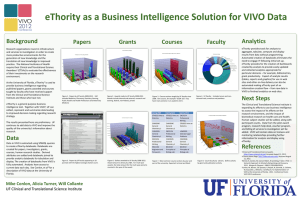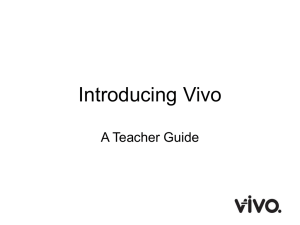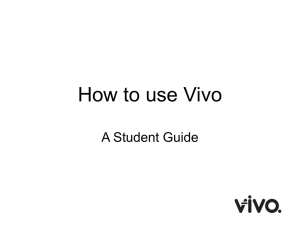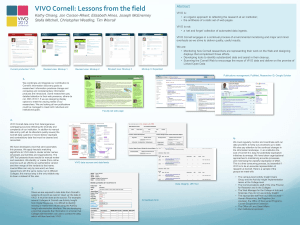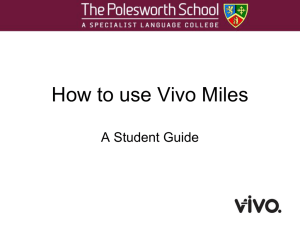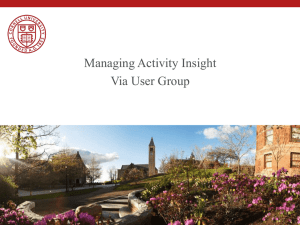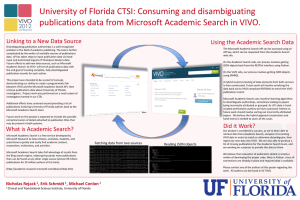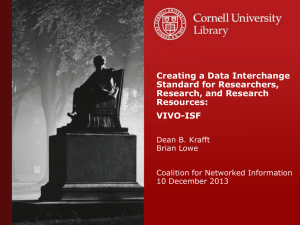Implementation of VIVO at the University of Florida
advertisement
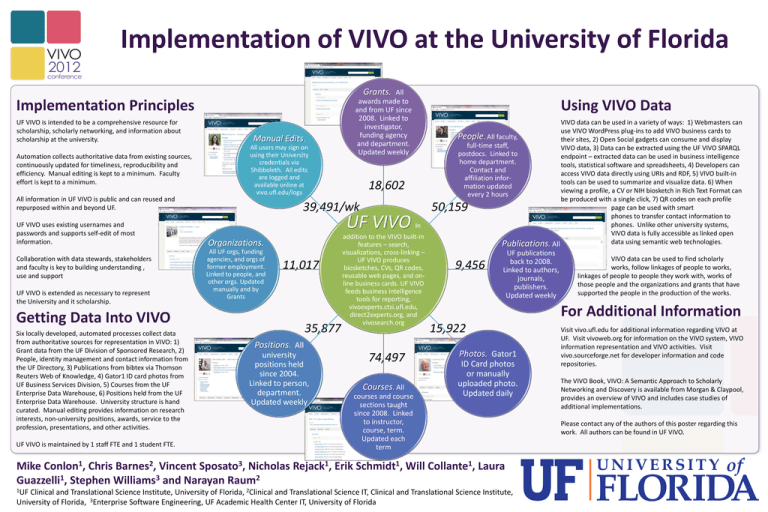
Implementation of VIVO at the University of Florida Grants. All Implementation Principles UF VIVO is intended to be a comprehensive resource for scholarship, scholarly networking, and information about scholarship at the university. Automation collects authoritative data from existing sources, continuously updated for timeliness, reproducibility and efficiency. Manual editing is kept to a minimum. Faculty effort is kept to a minimum. All information in UF VIVO is public and can reused and repurposed within and beyond UF. UF VIVO uses existing usernames and passwords and supports self-edit of most information. Collaboration with data stewards, stakeholders and faculty is key to building understanding , use and support UF VIVO is extended as necessary to represent the University and it scholarship. Manual Edits. All users may sign on using their University credentials via Shibboleth. All edits are logged and available online at vivo.ufl.edu/logs UF VIVO is maintained by 1 staff FTE and 1 student FTE. Using VIVO Data 18,602 39,491/wk UF VIVO Organizations. All UF orgs, funding agencies, and orgs of former employment. Linked to people, and other orgs. Updated manually and by Grants 11,017 Getting Data Into VIVO Six locally developed, automated processes collect data from authoritative sources for representation in VIVO: 1) Grant data from the UF Division of Sponsored Research, 2) People, identity management and contact information from the UF Directory, 3) Publications from bibtex via Thomson Reuters Web of Knowledge, 4) Gator1 ID card photos from UF Business Services Division, 5) Courses from the UF Enterprise Data Warehouse, 6) Positions held from the UF Enterprise Data Warehouse. University structure is hand curated. Manual editing provides information on research interests, non-university positions, awards, service to the profession, presentations, and other activities. awards made to and from UF since 2008. Linked to investigator, funding agency and department. Updated weekly 35,877 university positions held since 2004. Linked to person, department. Updated weekly 50,159 In addition to the VIVO built-in features – search, visualizations, cross-linking – UF VIVO produces biosketches, CVs, QR codes, reusable web pages, and online business cards. UF VIVO feeds business intelligence tools for reporting, vivoexperts.ctsi.ufl.edu, direct2experts.org, and vivosearch.org Positions. All 74,497 Courses. All courses and course sections taught since 2008. Linked to instructor, course, term. Updated each term VIVO data can be used in a variety of ways: 1) Webmasters can use VIVO WordPress plug-ins to add VIVO business cards to People. All faculty, their sites, 2) Open Social gadgets can consume and display full-time staff, VIVO data, 3) Data can be extracted using the UF VIVO SPARQL postdocs. Linked to endpoint – extracted data can be used in business intelligence home department. tools, statistical software and spreadsheets, 4) Developers can Contact and access VIVO data directly using URIs and RDF, 5) VIVO built-in affiliation infortools can be used to summarize and visualize data. 6) When mation updated viewing a profile, a CV or NIH biosketch in Rich Text Format can every 2 hours be produced with a single click, 7) QR codes on each profile page can be used with smart phones to transfer contact information to phones. Unlike other university systems, VIVO data is fully accessible as linked open data using semantic web technologies. Publications. All 9,456 UF publications back to 2008. Linked to authors, journals, publishers. Updated weekly For Additional Information 15,922 Photos. Gator1 ID Card photos or manually uploaded photo. Updated daily Mike Conlon1, Chris Barnes2, Vincent Sposato3, Nicholas Rejack1, Erik Schmidt1, Will Collante1, Laura Guazzelli1, Stephen Williams3 and Narayan Raum2 1UF VIVO data can be used to find scholarly works, follow linkages of people to works, linkages of people to people they work with, works of those people and the organizations and grants that have supported the people in the production of the works. Clinical and Translational Science Institute, University of Florida, 2Clinical and Translational Science IT, Clinical and Translational Science Institute, University of Florida, 3Enterprise Software Engineering, UF Academic Health Center IT, University of Florida Visit vivo.ufl.edu for additional information regarding VIVO at UF. Visit vivoweb.org for information on the VIVO system, VIVO information representation and VIVO activities. Visit vivo.sourceforge.net for developer information and code repositories. The VIVO Book, VIVO: A Semantic Approach to Scholarly Networking and Discovery is available from Morgan & Claypool, provides an overview of VIVO and includes case studies of additional implementations. Please contact any of the authors of this poster regarding this work. All authors can be found in UF VIVO.
